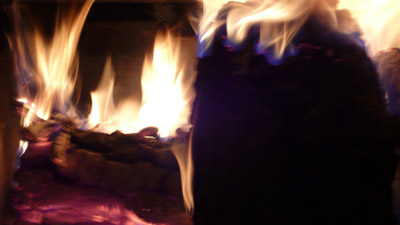
Wood on the stove at Urban Homestead, 2009. Courtesy Nance Klehm.
Urban Homestead is a residency run out of Chicago-based ecologist Nance Klehm‘s home. Residents stay with Nance for various periods of time and help keep the home running. This includes working in its huge yard garden, herding quail, and helping compost among other things. According to the website, Urban Homestead “is a residence that is open to working travelers and out-of-towners for stays of a few days to a few weeks and sometimes a few months. It fills the niche of people who find themselves in Chicago perhaps working on art or research or cultural connections who want to live in an urban immigrant neighborhood in a house that has an ecological emphasis.”
Nance invited two past residents to answer my questions with her. The first is Peter Olsen, enrolled at the Jutland Art Academy in Arhus, Denmark and currently on a self-study course in Chicago. He was resident for three weeks in September 2009. The second is Sarah Kavage of Seattle, WA, resident for one week in May 2009.
Bryce Dwyer: Do you see a connection between the practice of homesteading and artistic practice in general?
Nance Klehm: Homesteading is part of my artistic practice. Homesteading inherently involves constant creative problem solving.
Sarah Kavage: I would say that connection is through physical labor, learning by doing, and creating something that exists in physical space.
BD: Would you describe a past resident’s project and speak about how the ecology of the residency influenced it?
SK: I was at the Urban Homestead to do preliminary research on an art project about agricultural production, exchange and distribution, which will begin with the purchase of 1000 bushels of wheat on the Chicago Mercantile Exchange.
Being immersed in the Urban Homestead prodded me to think more deeply about what I was doing, and how to use this project to create real nourishment and abundance. There was a grounding and a clarity that came from being in a space that was a whole system – where I wasn’t just a consumer, but a part of a cycle. I weeded the garden and these weeds became dinner for me and Nance, two chickens and a bunny. The chickens made eggs for breakfast. Our dishwater watered the plants. Our poop (eventually) became manure. It was glorious to think about all that was happening on this little tiny speck of land in the middle of one of the largest urban areas in the country. If you asked me, I’d say, “Of course you get out of life what you put into it,” but the Urban Homestead was a physical lesson in actually doing that.
Peter Olsen: The projects I normally do take place in the area that surrounds me and in public space, so I was very influenced by staying here. First, the location of the residence: an interesting Mexican neighborhood [Chicago’s Little Village -BD]. An area you have to face and forces you to think about a Mexican society placed in Chicago. Gangs, Mexican families, Spanish and tortillas everywhere. No white people but me (and Nance). While living in this area I got a very different view of Chicago than if I had lived anywhere else.
BD: What role do you play in the production of the work/research made by residents during their stay at Urban Homestead?
NK: I aim to help orient residents to the Chicago that they need and want to know while they are here.
PO: While staying in the residency, I got connected with a lot of different people via Nance and all the people she knows. It gave me many new possibilities to find out what’s going on in the city, as well as the opportunity to make projects with people I would never have met myself. I also got a look into another way of living and working. Felt the energy from a person who really burns for what she is doing. It was very inspiring.
SK: Nance served as a resource for me and helped me get connected to a community in Chicago, the one that exists at the intersection between art and agriculture….this was of course in addition to her role as teacher of her homesteading practice.



